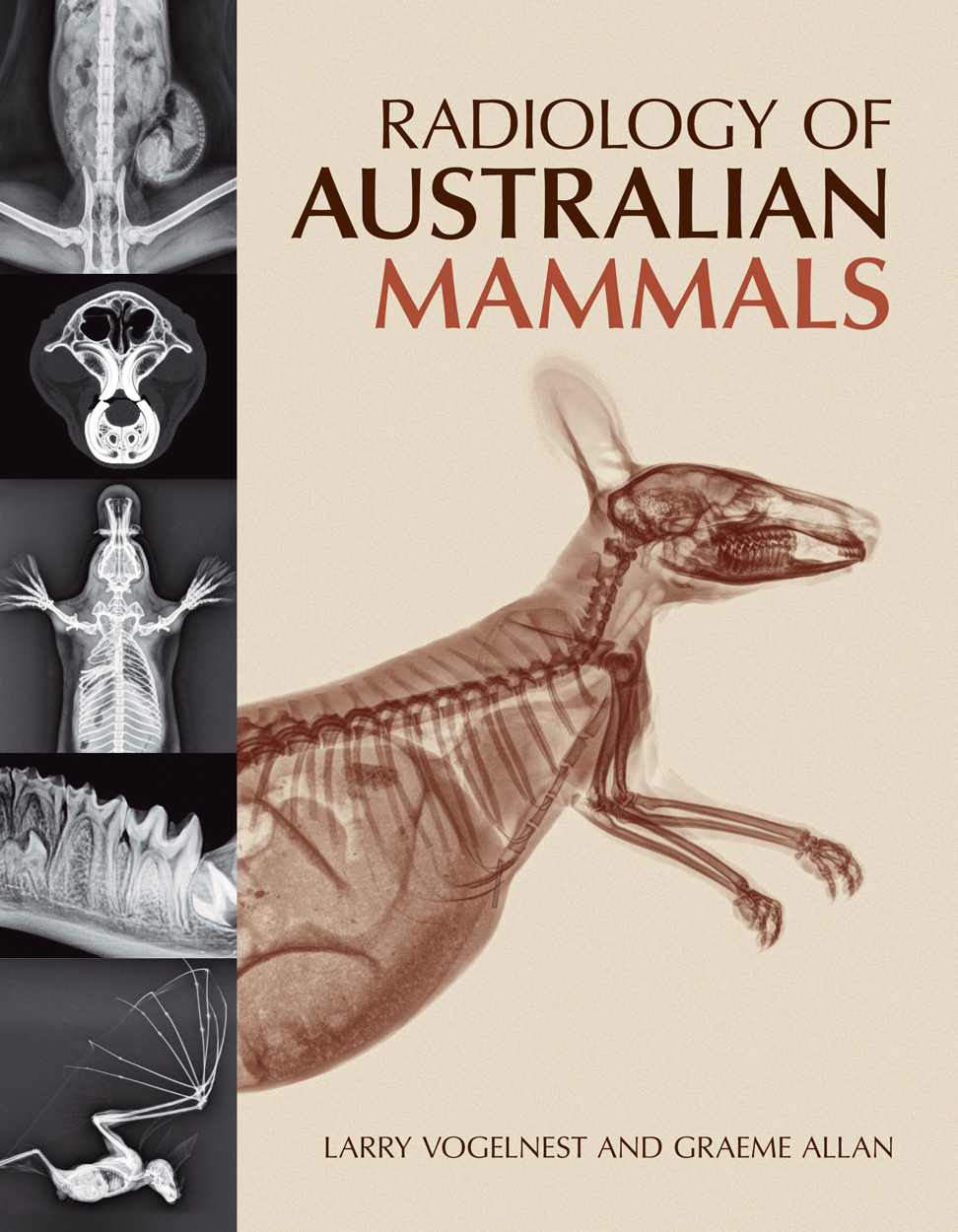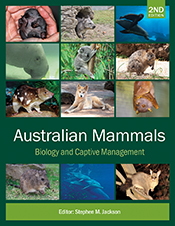Radiology of Australian Mammals
By: Larry Vogelnest, Graeme Allan
How to interpret radiographs of native mammals in order to make informed decisions on diagnosis, prognosis and treatment.
Interest in the conservation and welfare of Australian native wildlife continues to grow. Veterinarians are frequently presented with injured, diseased or orphaned animals and there is increasing veterinary involvement in conservation programs. In Australia and overseas, Australian mammals are used in research, kept as pets and are popular display and education animals in zoos and fauna parks. + Full description
The recognition, diagnosis and treatment of injury and disease in wildlife species present unique challenges for the veterinarian. Radiology is a fundamental diagnostic tool that can be used to further define the nature and extent of injury or disease, guide therapeutic decisions and determine prognosis. An essential aspect of radiology is the recognition and description of abnormal findings. In order to recognise abnormalities, knowledge of normal radioanatomy is necessary. Radiology of Australian Mammals provides a detailed reference on the normal radioanatomy of Australian mammals.
A chapter on radiographic technique covers digital radiography of small species, and restraint and positioning to obtain diagnostic images. This is followed by chapters covering the normal radioanatomy of the short-beaked echidna, platypus, macropods, koala, wombats, dasyurids, possums and gliders, bandicoots and the bilby, and bats. Each chapter includes a detailed description of anatomy relevant to radiography and multiple images of normal radiographs with outlines and annotations identifying relevant structures. A chapter on dental radiology discusses and demonstrates normal dental radioanatomy. The final chapter includes selected radiographic pathology case studies providing an appreciation of radiographic findings seen in some common diseases of Australian mammals. A checklist of the mammals of Australia and its territories and a glossary of abbreviations and terms used for annotation of images complete the volume.
- Short descriptionReviews
"This is a unique and comprehensive book that will become a valuable resource for those working with Australian wildlife. With increasing interest in the conservation and welfare of Australian native wildlife, Radiology of Australian Mammals will be of use to veterinarians, zoologists and veterinary students, both in Australia and also overseas where Australian mammals are kept in zoos and wildlife parks."
Dr Phil Tucak, Australian Veterinary Journal 93(12), 2015, pp. 465
"This book is an essential reference for anyone (practitioner, radiologist, nurse, and student) who might deal with Australian mammals. If you don't think you are likely to radiograph a wombat or possum soon, buy a copy anyway and leave it on your coffee table next time you have guests. It is fun to read (yes, I am a radiology-nerd), it will be a great conversation-starter and you will look like a most sophisticated practitioner!"
Zoe Lenard, Centre for Veterinary Education Control & Therapy Series, Issue 282, March 2016, pp. 23-24
"This is an extremely accessible, practical book, logically organised and indexed for easy reference. The authors and contributors have done an incredible job compiling such a breadth of images.
This is the first and only comprehensive resource on the normal radioanatomy of Australian mammals. As such it will prove a useful addition to every practice library, but especially those with a wildlife caseload. It will also be beneficial to veterinary students, nurses and those working in zoos and sanctuaries. For the high production quality and comprehensive content it represents excellent value."
Anne Fawcett, The Veterinarian, October 2015
"Aside from being a book one can simply browse through, marveling at the images, Radiology of Australian Mammals has a lot to offer from a technical aspect as well. Vogelnest and Allen have collected sample radiographs and diagnoses across nearly all families of Australian mammals, including both healthy and injured specimens. This is ultimately where the text’s strength lies: in providing the first comprehensive reference material for Australian mammal radiography."
William Geary, Wild Melbourne (blog), 24/11/15
"The radiographic images in this book are the real stars of the show: most are crisp, sharply defined, and have excellent contrast. Some images are particularly striking, notably several of female marsupials showing pouch young in situ... This book will be essential for vets working in Australia, particularly those in rural and suburban areas where they are likely to regularly encounter injured native wildlife."
Robin M. D. Beck, Journal of Mammalian Evolution, 2016
"Radiology of Australian Mammals is a highly commendable effort that will have enormous practical value for decades to come. As written, it is also an easily accessible resource for any interested general audience. It is surely a "must buy" for any veterinarian engaged in the care of mammalian wildlife in Australia."
Scott Carver, The Quarterly Review of Biology, Vol 91, June 2016, pp 230-231
Details
Hardback | June 2015 | $180.00ISBN: 9780643108646 | 320 pages | 270 x 210 mm
Publisher: CSIRO Publishing
Photographs
ePDF | June 2015
ISBN: 9780643108653
Publisher: CSIRO Publishing
Available from eRetailers
Features
- Detailed descriptions of anatomy, highlighting unique features of the taxonomic group
- Comprehensively illustrated with detailed, high quality digital radiographs
- Illustrates normal radiographic anatomy, allowing veterinary practitioners to identify what is abnormal in their patients
- A useful reference for students and zoologists studying anatomy and biology of Australian mammals
- Depicts common diseases and injuries that can be visualised radiographically
Contents
Preface1 Radiographic technique
2 Short-beaked echidna
3 Platypus
4 Macropods (potoroids and macropodids)
5 Koala (co-authored by Dr Susan Hemsley)
6 Wombats
7 Dasyurids
8 Possums and gliders
9 Bandicoots and Bilby
10 Bats
11 Dental radiology (Nadine Fiani)
12 Radiographic pathology case studies (Frances Hulst, Graeme Allan, Larry Vogelnest)
Appendix 1 A checklist of the mammals of Australia and its territories (Paul Andrew)
Index
Authors
Dr Larry Vogelnest has been employed as a veterinarian with the Taronga Conservation Society Australia since January 1990. He has been Senior Veterinarian at Taronga Zoo since July 1994 and is responsible for the health and welfare of the zoo’s animal population and wildlife admitted to the Taronga Wildlife Hospital. In 1990 Dr Vogelnest completed a Masters in Veterinary Studies in Wildlife Medicine and Husbandry. In 1996 he gained membership to the Australian College of Veterinary Scientists by examination in Zoo Animal Medicine. Dr Vogelnest is the Principal Editor of Medicine of Australian Mammals (CSIRO Publishing, 2008). In 2009 he was awarded an Australian Public Service Medal for his contribution to conservation medicine and service to the Taronga Conservation Society Australia. Dr Vogelnest specialises in the health and reproductive management of small populations including ex situ breeding programs for endangered species. He has participated in and advised on both in situ and ex situ components of numerous conservation projects.Dr Graeme Allan worked in private practice for 11 years, during which time he was awarded an MVSc degree from the University of Sydney for his research into radiography of the biliary system of dogs. In 1973 he gained membership of the Australian College of Veterinary Scientists by examination. In 1977 he commenced a training program in Veterinary Radiology at Cornell University in New York, USA, which culminated in successfully completing the examinations in 1979 that permitted him to qualify as a Diplomate of the American College of Veterinary Radiology. He returned to Australia to commence practice as a specialist veterinary radiologist, in which capacity he has continued to this day. In 1982 he was admitted to Fellowship of the Australian College of Veterinary Scientists by examination. During the last 20 years Dr Allan has taught small animal radiology to undergraduates at the University of Sydney and to graduate veterinarians through the Centre of Veterinary Education at the University of Sydney. He was awarded the TG Hungerford Award for Excellence in Post Graduate Education by the Post Graduate Foundation in Veterinary Science at the University of Sydney in 1993 and the Seddon Memorial Prize by the NSW Division of the AVA in 1999. Dr Allan is published widely in the veterinary literature. He has been a faculty member at the Veterinary Faculty at the University of Sydney and in 1999 was appointed Adjunct Professor of Veterinary Science within the Faculty. In 2012 he was awarded a DVSc by the University of Sydney after examination of his thesis entitled 'Radiological Studies of Diseases in Companion and Zoo Animals'.








